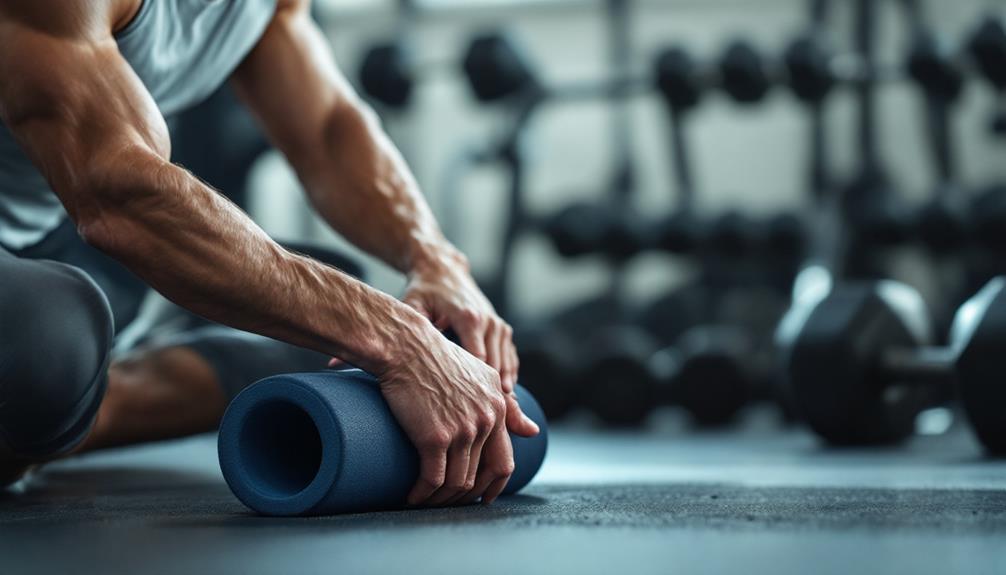To improve recovery after heavy lifting, prioritize post-workout nutrition with protein and carbs. Stay hydrated throughout the day, especially before and after workouts. Implement active recovery techniques like light exercise on rest days. Optimize your sleep quality with a consistent schedule and sleep-friendly environment. Use compression gear to reduce muscle soreness and fatigue. Consider foam rolling for muscle recovery. Manage stress levels to support overall recovery. Apply cold therapy to reduce inflammation. Supplement wisely with proven options like whey protein and creatine. Finally, listen to your body and adjust your routine as needed. These tips will help you maximize your strength gains and prevent injuries.
Core Insight
- Prioritize post-workout nutrition with protein and carbohydrates to support muscle repair and replenish energy stores.
- Implement active recovery techniques like light exercise, foam rolling, and stretching to promote blood flow and reduce stiffness.
- Optimize sleep by establishing a consistent schedule and creating a sleep-friendly environment for enhanced recovery.
- Stay hydrated by drinking water throughout the day and consuming electrolyte-rich beverages after intense lifting sessions.
- Wear compression gear post-workout to reduce muscle soreness, decrease swelling, and improve blood circulation.
Prioritize Post-Workout Nutrition

Three main things should guide your post-workout nutrition: protein, carbohydrates, and hydration.
Protein is important for muscle repair and growth. Look for good sources like whey protein, chicken, or eggs. Carbohydrates help to restore your energy levels by replenishing glycogen stores. Choose complex carbs such as whole grains, sweet potatoes, or fruits. Adding a Vitamin D3 supplement can also help with muscle recovery and support your immune system.
Don't forget to rehydrate. You lose fluids when you sweat, so drink water or an electrolyte-rich drink to help restore balance. Timing is important too; try to eat your post-workout meal within 30 to 60 minutes after exercising, as this is when your body is best able to use the nutrients.
A protein shake with added carbs can be a convenient option, or you can prepare a balanced meal in advance. Remember, being consistent with your post-workout nutrition is key to recovering well and reaching your fitness goals.
Hydrate Strategically

Your hydration needs don't stop when you finish lifting weights. It's important to replace the fluids you lost during your workout and stay hydrated for better recovery. Try to drink water regularly throughout the day, not just during or after your exercise.
Here's a simple guide to help you hydrate effectively:
| Time | Hydration Strategy |
|---|---|
| Pre-workout | Drink 16-20 oz of water (2-3 hours before) |
| During workout | Sip 7-10 oz every 10-20 minutes |
| Post-workout | Drink 16-24 oz for every pound lost |
| Throughout day | Aim for 8-10 glasses of water |
| Before bed | Drink 8 oz of water |
If you sweat a lot or exercise in hot weather, consider adding electrolytes to your water. This helps replace minerals lost in sweat and supports your muscles. Remember, staying properly hydrated is key to improving your recovery and overall performance.
Implement Active Recovery Techniques

Staying hydrated is important, but it's not the only way to help your body recover after heavy lifting. Using active recovery techniques can really boost your recovery. Try adding light, low-impact exercises on your rest days. This could be gentle yoga, swimming, or a brisk walk. These activities improve blood flow, which helps reduce muscle soreness and stiffness.
Foam rolling or self-massage is another great option. High-density foam rollers work well for deep tissue massage, targeting areas like the IT band, hamstrings, and lower back. This helps relieve muscle knots and increases blood flow to tired muscles. Stretching is also beneficial, as it can improve flexibility and lower the chances of injury.
Lastly, consider contrast therapy, which involves alternating hot and cold treatments. This can help reduce inflammation and speed up recovery. By adding these active recovery methods to your routine, you may notice better performance and less downtime between workouts.
Optimize Sleep Quality

To help your muscles recover after heavy lifting, it's important to get good sleep. Here are some simple ways to improve your sleep quality:
- Create a Sleep-Friendly Environment: Make your bedroom dark, quiet, and cool. A comfortable mattress and supportive pillows can help you sleep better. You might also try using sleep aids like eye masks or pillow sprays.
- Stick to a Sleep Schedule: Aim for 7-9 hours of sleep each night. Going to bed and waking up at the same time every day can help.
- Wind Down Before Bed: Avoid screens and do relaxing activities to prepare for sleep.
Here are a few more tips:
- Stay away from caffeine and alcohol close to bedtime.
- Practice deep breathing or meditation to help reduce stress.
- Use blackout curtains or a sleep mask to block out light.
Utilize Compression Gear

One effective way to help you recover after a workout is by using compression gear. These snug-fitting clothes can reduce muscle soreness and fatigue after intense lifting sessions. When you wear compression clothing, it applies gentle pressure to your muscles, which can improve blood flow and decrease swelling.
Cold therapy compression wraps can enhance this effect by adding cold therapy to the compression, helping to reduce inflammation even more. These wraps work well for specific muscle groups and can be a great addition to your recovery routine.
To get the best results, choose compression gear that fits well and targets the muscles you've worked. For example, if you focused on your legs, go for compression tights or sleeves. Wear the gear right after your workout and keep it on for a few hours to maximize the benefits.
Practice Proper Stretching

How can you recover better after heavy lifting? One important part of your post-workout routine is stretching. Stretching helps improve flexibility, reduce soreness, and prevent injuries. After lifting weights, take some time to stretch the muscles you worked. Using foam rollers can also help by targeting deeper tissues and improving blood flow.
Here are some key stretching methods to focus on:
- Static stretches: Hold each stretch for 15-30 seconds.
- Dynamic stretches: Move gently and in a controlled way.
- Foam rolling: Focus on specific muscle groups to relieve tension.
Make sure to breathe deeply and avoid bouncing while you stretch. Start with larger muscle groups and then move to smaller ones. Stretching should feel good, not painful, so don't push yourself too hard. Include stretching in your cool-down routine to help your body transition from intense exercise to rest. By regularly practicing proper stretching, you can enhance your recovery and improve your overall performance.
Consider Foam Rolling

Foam rolling is a great way to enhance your post-workout routine. It helps relieve muscle tightness and boosts blood flow to sore areas. To get started, focus on larger muscle groups like your quads, hamstrings, and back. You might also want to use a cooling towel alongside foam rolling to help reduce muscle swelling and soreness.
To foam roll, place the roller under the muscle you want to target and gently roll back and forth. If you find a tender spot, stop and press down for 20-30 seconds. Take your time with this—spend about 1-2 minutes on each muscle group. Remember to breathe deeply and stay relaxed as you roll.
For the best results, foam roll before you stretch. This can help improve your flexibility and make stretching more effective. Be gentle with yourself, especially if you're just starting out or feeling sore from your workout.
Manage Stress Levels

Managing stress is key for recovering well after lifting weights. When you are stressed, your body struggles to fix and rebuild muscle. Adaptogenic supplements can help manage stress and support recovery. To keep stress low, focus on these important areas:
- Sleep: Try to get 7-9 hours of good sleep each night.
- Nutrition: Eat a balanced diet full of whole foods.
- Relaxation techniques: Use methods like meditation or deep breathing to relax.
Incorporate Cold Therapy

Cold therapy is an effective way to help you recover after workouts. It can reduce swelling, relieve muscle soreness, and speed up healing. You can easily add cold therapy to your routine with ice baths, cold showers, or ice packs. Here's a simple guide to different cold therapy methods:
| Method | Duration | Frequency |
|---|---|---|
| Ice bath | 10-15 mins | 2-3 times a week |
| Cold shower | 3-5 mins | Daily |
| Ice packs | 15-20 mins | As needed |
Start with shorter times and slowly increase as you get used to it. Pay attention to how your body feels and stop if you feel any pain. Always wrap ice packs in a thin towel to protect your skin. For the best results, use cold therapy within 30 minutes after your workout. And remember to warm up afterward to avoid stiffness.
Supplement Wisely

Certain supplements can help you recover better after heavy lifting. When you choose the right ones, they can reduce muscle soreness, cut down inflammation, and speed up healing. It's important to pick supplements that have scientific backing and fit your needs. For example, micronized creatine powder is great because it absorbs quickly and mixes well in your post-workout drink. Make sure to choose products that are third-party tested for quality and purity.
Here are some supplements to consider adding to your post-workout routine:
- Whey protein: Helps repair and build muscles.
- Creatine: Boosts strength and aids recovery.
- Omega-3 fatty acids: Reduces inflammation.
Frequently Asked Questions
How Long Should I Wait Before Lifting Heavy Again After a Session?
Imagine you're a bodybuilder preparing for a competition. You should wait 48-72 hours before lifting heavy again after a session. This allows your muscles to repair and grow stronger. Listen to your body and adjust accordingly.
Can Massage Therapy Help With Muscle Recovery After Intense Weightlifting?
Yes, massage therapy can help with muscle recovery after intense weightlifting. It'll increase blood flow, reduce muscle tension, and alleviate soreness. You'll experience faster recovery times and improved flexibility, allowing you to get back to lifting sooner.
Are Ice Baths More Effective Than Contrast Therapy for Recovery?
As cool as a cucumber, you'll find ice baths and contrast therapy both effective for recovery. However, ice baths may have a slight edge in reducing inflammation and muscle soreness. You'll need to experiment to see what works best for you.
How Do I Prevent Delayed Onset Muscle Soreness (Doms) After Heavy Lifting?
To prevent DOMS, you should gradually increase workout intensity, focus on proper form, and warm up before lifting. Don't forget to cool down, stretch, and stay hydrated. Getting enough sleep and protein intake also helps reduce soreness.
Is It Beneficial to Take Rest Days Between Heavy Lifting Sessions?
Yes, it's important to take rest days between heavy lifting sessions. You'll allow your muscles time to repair and grow stronger. It's essential for preventing overtraining, reducing injury risk, and optimizing your overall performance and progress.

